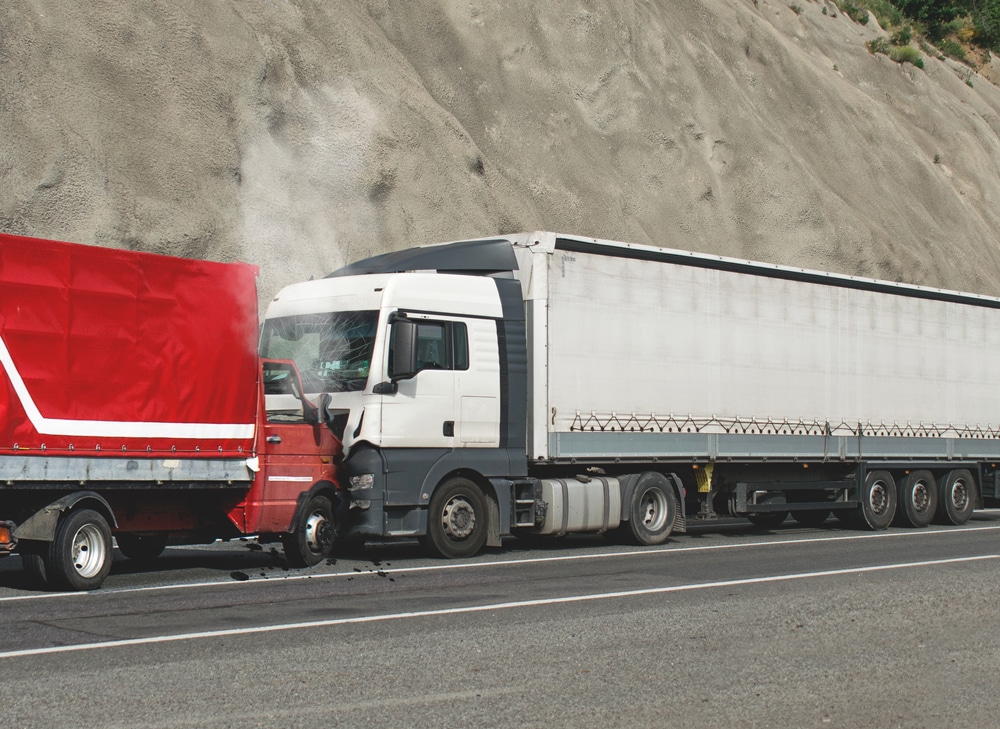Operating a semi-truck without its trailer, or bobtailing, might seem like a safer, lighter mode of transport. But the reality is far more dangerous than many realize. These seemingly stripped-down 18-wheelers pose serious risks on the road, even in the hands of experienced drivers. In fact, bobtailing accidents are often more likely due to the unique handling challenges and weight distribution issues involved.
In this article, we’ll explore the definition of bobtailing, uncover why driving a semi without a trailer is so risky, and explain what to do if you’ve been injured in a crash involving a bobtail truck. Understanding the dangers of bobtail driving can help prevent accidents and protect your legal rights after a collision, regardless of whether you’re a motorist sharing the road or a driver behind the wheel of a big rig.
What Is Bobtailing?
In trucking, bobtailing refers to driving a semi-truck, also known as a big rig or 18-wheeler, without a trailer attached. This often happens after a load has been delivered or when the driver is en route to pick up a new trailer.
The term comes from the visual similarity to an animal with its tail cut short, in this case, the “tail” being the trailer. And while a truck without the trailer may look like a lighter, more nimble vehicle, the reality is the opposite; bobtailing trucks are more dangerous to operate than fully loaded ones.
Related Reading: Semi-Truck Accident Lawsuits: How Much Compensation Can You Expect?
Why Trucks Aren’t Designated to Be Driven Without a Trailer
Semi-trucks are engineered to operate as a combined unit, with the trailer carrying most of the load. The system of suspension, braking, and handling is finely tuned for this configuration.
Here’s why bobtailing disrupts this balance:
- Weight Distribution: With a trailer, most of the weight sits over the rear axles, which gives the truck better traction and braking ability. When bobtailing, that weight is gone, and the balance shifts forward, reducing grip on the rear tires.
- Braking Power: Most of a truck’s braking force comes from the rear wheels, located under the trailer. Without a trailer, these brakes are far less effective. This is one reason why bobtailing increases stopping distances dramatically.
- Steering Sensitivity: A bobtailing truck becomes more difficult to handle, especially when turning or braking suddenly. The lack of rear weight makes the cab more prone to fishtailing or skidding.
In essence, a bobtail truck isn’t just “half a truck,” it’s an inherently unstable vehicle, especially in emergency situations.
Why is Bobtailing Dangerous?
It might surprise some to learn that bobtailing accidents can be more likely to happen than those involving fully loaded trucks. Despite weighing less, a bobtail semi has less stability, poorer braking, and more sensitive steering. These factors combine to make it dangerous at high speeds or in poor weather.
Increased Stopping Distances
A fully loaded semi-truck already takes longer to stop than a passenger vehicle. At 65 mph, a loaded semi may need over 525 feet to stop, 40% longer than the average car. When bobtailing, that stopping distance can increase even more, as the truck’s brakes aren’t being used in their optimal configuration.
Reduced Traction
With less weight over the rear tires, bobtail trucks have reduced traction, especially on wet, icy, or slick roads. Even experienced drivers can struggle to maintain control in these conditions. When turning or swerving, the risk of jackknifing or skidding increases significantly.
Handling Difficulties
Bobtail driving is harder to control, even under normal circumstances. The truck’s weight is unevenly distributed, which impacts how the vehicle reacts to steering input. This makes quick reactions more dangerous and increases the likelihood of losing control.
Risk of Collisions
Other vehicles on the road pose another danger. Bobtail drivers must constantly account for sudden stops, lane changes, or merges by cars, but their vehicles’ reduced braking and traction make avoiding collisions more difficult. Even if a trucker reacts quickly, the truck may not.
Fatigue and Human Error
Driver fatigue is a leading cause of all truck accidents, including bobtailing accidents. Long hours, poor sleep, and monotonous road conditions can impair judgment and reaction time. If a tired driver is bobtailing and encounters a hazard, the margin for error is slim.
Related Reading: Truck Accidents Caused by Driver Fatigue: How Common Are They?
What Causes Bobtailing Accidents
Bobtailing accidents can result from several common risk factors:
- Poor weather conditions (rain, snow, ice)
- Sudden braking or turning
- Inexperienced drivers not trained for bobtail handling
- Fatigue or distracted driving
- Other motorists cutting off trucks or merging unsafely
- High speeds that exceed safe limits for bobtail operation
In each of these scenarios, the unique physics of bobtail trucking turns what might otherwise be a manageable situation into a potentially catastrophic collision.
Can You Claim Compensation After a Bobtailing Accident?
Yes, but as with all truck accident cases, liability depends on who was at fault and whether negligence can be proven.
Truck drivers, even when bobtailing, are still required to follow Federal Motor Carrier Safety Administration (FMCSA) regulations. This includes hours-of-service rules to prevent fatigue and general driving conduct standards. If a trucker fails to meet these obligations and causes a crash, they can be held liable.
Examples of truck driver negligence:
- Driving while fatigued is in violation of FMCSA rules
- Failing to account for the increased stopping distance
- Speeding or making aggressive maneuvers
- Operating the truck in unsafe weather conditions
Examples of trucking company negligence:
Sometimes, the fault lies not with the driver, but with the company:
- Failing to train drivers on how to handle bobtail trucks
- Forcing drivers to operate beyond regulated hours
- Not maintaining the truck’s braking systems properly
In these cases, the trucking company may be liable for the accident.
What If You Share Some Responsibility?
Texas follows a modified comparative negligence rule. If you are less than 51% at fault, you can still recover compensation, but your award may be reduced by your percentage of responsibility.
For example, if you cut off a bobtailing truck in traffic and the driver couldn’t stop in time, you might be found partially liable. This would affect how much you could recover in a claim.
What to Do If You’ve Been Injured in a Bobtailing Accident
Whether you were hit by a bobtail truck as a driver, pedestrian, or cyclist, taking swift action is critical. Here’s what you should do to protect your health and legal rights:
1. Seek Immediate Medical Attention
Even if you feel fine, internal injuries or concussions can take time to show symptoms. Prompt treatment ensures your health and establishes a medical record that ties your injuries to the accident.
2. Document the Scene
If possible, take photos or videos of:
- The trucks and your vehicle
- Road conditions
- Visible injuries
- Traffic signs or signals
Collect the names and contact information of any eyewitnesses.
3. Follow Your Treatment Plan
Skipping appointments or ignoring your doctor’s advice can give insurers ammunition to argue that your injuries aren’t serious or were worsened by your inaction.
4. Speak to an Attorney
Truck accident cases, including those involving bobtailing, are complex. A personal injury lawyer can:
- Investigate the accident
- Determine if the trucker or the employer was negligent.
- Identify whether bobtail insurance applies (some trucking companies carry this specialized coverage for when a trucker is between loads)
- Negotiate with insurers and fight for maximum compensation.
Related Reading: Why Hire a Personal Injury Lawyer?
What Damages Can You Recover?
If you were injured in a bobtailing accident, you may be entitled to economic and non-economic damages.
Economic damages include:
- Medical bills (including future treatment)
- Lost wages
- Loss of earning capacity
- Property damage
Non-economic damages include:
- Pain and suffering
- Emotional distress
- Loss of enjoyment of life
- Loss of companionship or consortium
In severe cases, you may also seek punitive damages if the truck driver or company acted with gross negligence.
Stay Aware of the Dangers of Bobtailing
Driving a semi-truck isn’t just a harmless in-between task. It’s a high-risk operation. From longer stopping distances and poor traction to reduced control and heightened crash risk, bobtailing accidents are a serious threat on the road.
Understanding the bobtail truck and its dangers is the first step in preventing accidents and ensuring accountability when crashes happen, regardless of if you’re a truck driver, motorist, or injured party seeking justice after a collision.
If you’ve been injured in a bobtailing accident, don’t wait. An experienced truck accident attorney can help you build a strong case and fight for the compensation you deserve.
Need Help After a Bobtail Accident in Texas?
At Patino Law Firm, we understand how devastating truck crashes can be. Our legal team in San Antonio and McAllen can investigate your case, identify liability, and help you recover the full value of your claim. We offer free consultations, and you don’t pay legal fees unless we win.
Contact us today at 855-LAW-NINJA for your free case review.





